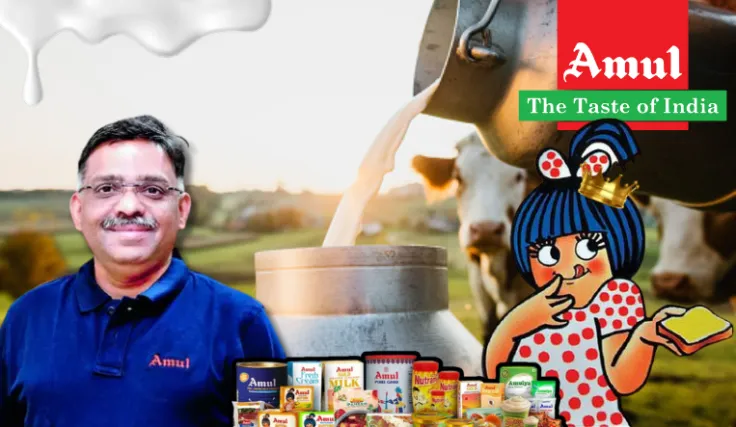On 14 December 1946, Tribhuvandas Kishibhai Patel laid the first brick on the grounds of Anand in Gujarat, India. In all these years, The company has been through the Indian Independence Era, World War II, and whatever conflicts and controversies covered in these 76 years.
Also, Read Unilever Announces New Chief Financial Officer
As stated by Business Today, On October 8th New York Times Square attracted the tourists by featuring India’s Big Brand- Amul. The Advertisement was titled ‘BE MORE MILK and was displayed for the passersby 24 hours a day. While reading this you must also know that Amul’s Advertising is on the Nasdaq Marketsite.
Since Its Inception, Amul has been winning hearts in India. The same was evident when for the financial year 2022-23, Amul’s annual turnover was around US$ 7.2 Billion. Amul which is a part of Gujarat Cooperative Milk Marketing Federation Ltd. is the apex organization in Gujarat. It started with an aim to provide good returns to the farmers and also provide the products with a good value of Money.
If we talk about marketing then Amul is amongst the brand that captures every eye by its Creatives. Whether it’s about India’s Voyage to the Moon or Durga Pooja celebration, Amul is the first to make the Amul Girl to the Indian Billboards.
Amul’s Ex MD RS Sodhi revealed that even in the period of the Pandemic, Amul Supply stood its ground. When the entire world was battling challenges that the widespread virus caused. Reportedly, Amul sold milk in over 1000 cities across India. He even stated that Amul delivered about 40 lakh liters of Milk per day during lockdown.
Talking about Today, This Dairy Giant is aiming to go aggressive on its portfolio plus in the organic segment. As per the reports of GCMMF, An Increase of over 18% from the previous year was reported. They even forstated the target for the financial year 2026 as one lakhs.
A few years back, Amul started establishing its hold on the FMCG sector. The growth started late but what did they have to lose? GCMMF's main revenue comes from Milk and Its Products. It’s True that No one can deny the epic taste that dissolves in the mouth starting with the packet of Kaju Katli or ending the meal over the dessert Shrikhand.
Amul still follows its same Motto as Before, Its closeness to the Farmers and a new aim to scale up the business. There’s a smile on every face working at Amul, especially MD Jayen Mehta, a believer in the success of this brand.
Amul approached the food industry methodically, launching new products over the course of at least ten years before stepping it up significantly presently. Chocolates' popularity is yet another intriguing example. Although chocolate was thought to be pricey, Amul introduced a 150-gram bar when the typical size was 40 or, at most, 80 grams. Amul then decided to go with dark chocolates, which are thought to be a healthier choice. With hardly any advertising, Amul has emerged as a major force in the chocolate industry today.
According to Jaiswal, the strategy for organic goods will be comparable to that of ice cream. According to him, there is still a shortage of organic food in India, and that market development requires significant investment from established players. "Amul's capacity to produce at scale and its relationship with farmers may result in reduced prices. Furthermore, there is a chance to democratize organic because there are now no major players in the market. The Indian market for organic foods was estimated by research firm IMARC Group to be worth $1.3 billion in 2017 and might grow to $4.6 billion by 2028.
“Amul’s marketing has been down-to-earth, simple, and focused on the product. They have never used celebrities, and the quality value has spoken for itself”
D. Shivakumar,
Operating Partner, Advent International
Also, Read, Train Collision in Andhra Pradesh Leaves Several Dead and Injured
Grain and pulses, on the other hand, have long-established distribution networks and are not as perishable. “Neither one farmer nor one region grows everything. For example, ITC buys tobacco in Guntur and wheat from elsewhere. That means the backend synergies at the farmer’s level are not obvious, though the capabilities are fungible in a sense,” he said. He added that It will be over a decade, and they will finally get it right, but one should not expect overnight success.
We know we have smiled our way through three consecutive generations celebrating festivities with trustworthy brand Amul. The King of the Dairy market still sits on the same throne when it comes to making choices with qualities.
Let’s continue to enjoy the packages of Happiness and watch the market grow!
Also, Read, Jio brings in Ericsson and Nokia to launch 5G SA in India
- Kratika Agarwal







